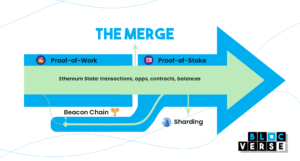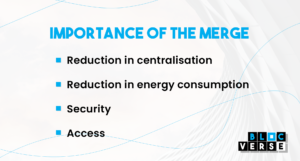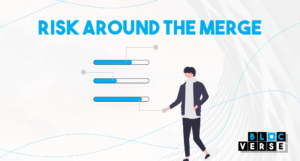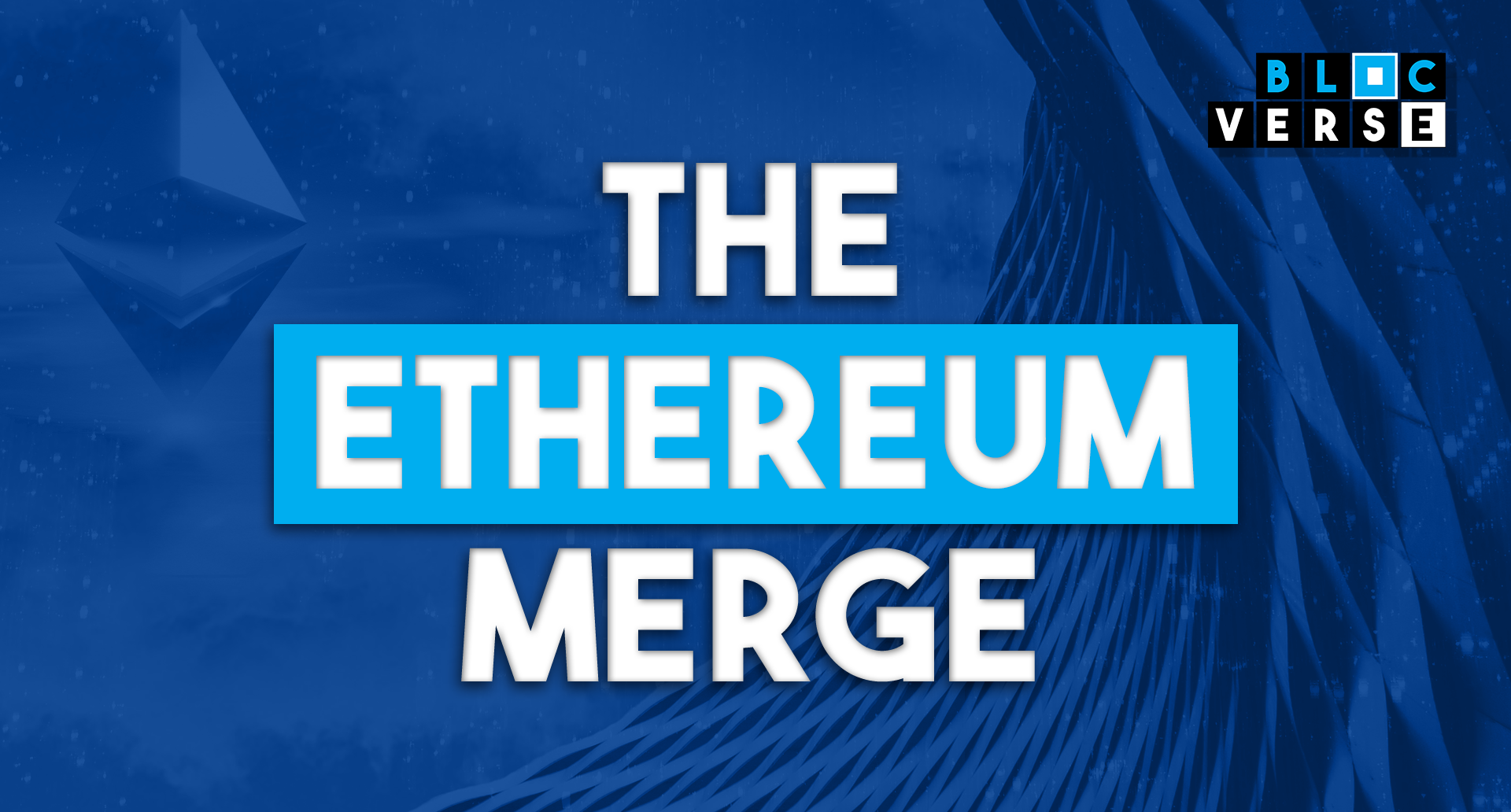Overview
The Ethereum blockchain’s “The Merge” has been the subject of much speculation and finally arrived. However, what exactly is The Merge, and why is it significant? The Ethereum Foundation calls it “the most significant upgrade in the history of Ethereum.” This fact hardly qualifies as an exaggeration.
The Ethereum Mainnet, which has been around since the project’s conception, and the Beacon Chain, a new layer of proof-of-stake consensus, were joined together during The Merge.
Currently, the Proof-of-stake is used on the Ethereum Mainnet, but it wasn’t always the case. Doing away with energy-intensive mining made it possible to protect the network using the staked ETH. Adding greater scalability, security, and sustainability was a fascinating step toward achieving the Ethereum mission.
This upgrade signifies a fundamental transformation in how the Ethereum blockchain operates and is the most significant event in the history of blockchain technology.
This article will explain what The Merge is, why it’s so significant, and what will likely occur next.
The subjects discussed in this article are summarized as follows:
- What Is The Merge?
- Merging with the Ethereum Mainnet
- Why Is The Merge Important?
- Risks Around The Merge
- Misconceptions Around The Merge
- The aftermath of the merge: What’s next?
What Is The Merge?
The Merge signifies Ethereum’s transition to proof-of-stake (PoS), its new system (or “consensus mechanism”) for certifying cryptocurrency transactions. Proof-of-work (PoW), the more energy-intensive process pioneered by Bitcoin, will be replaced by the new system.
Beacon Chain, Ethereum’s Proof-of-Stake network, was launched in 2020; however, until the 15th of September 2022, there was no usage of the Proof-of-Stake for transaction processing.

Instead, it was kept in readiness for the PoS upgrade, serving as a holding facility for the machines that run the Ethereum network. To complete the switch from PoW to PoS, Ethereum’s mainnet and the Beacon Chain (the “Consensus” layer) had to be combined.
Merging With The Ethereum Mainnet
From its inception until The Merge, the Ethereum Mainnet was protected via Proof-of-Work. This method allowed the Ethereum blockchain we are all familiar with to be created in July 2015, complete with transactions, smart contracts, accounts, etc. Throughout Ethereum’s existence, its developers have prepared for the eventual switch from PoW (proof-of-work) to PoS (proof-of-stake)
The Beacon Chain was launched as a new blockchain operating parallel with Mainnet on the 1st of December 2020. The Beacon Chain initially did not process Mainnet transactions. Instead, it gained consensus on its state by determining which validators were active and their respective account balances.
After considerable testing, it was time for the Beacon Chain to reach a consensus regarding data from the actual world. Beacon Chain is now the consensus engine for all network data, including execution layer transactions and account balances, resulting from The Merge.
The Merge signified the adoption of the Beacon Chain as the block manufacturing engine. As a result, mining is no longer used to create valid blocks. In its place, proof-of-stake validators now process the authenticity of all transactions and propose new blocks.
The Merge did not affect the past. As Mainnet joined with the Beacon Chain, the complete Ethereum transaction history likewise merged.
Why Is “The Merge” Important?
There are significant distinctions between proof-of-work consensus mechanisms and proof-of-stake consensus mechanisms. These modifications will have short- and long-term effects on the Ethereum network.
A. Reduction in centralization
Decreased energy usage and enhanced accessibility will have a third effect: diminished centralization. Proof-of-work blockchains tend to be more centralized since proof-of-work miners pool their computing resources in consortiums to enhance their chances of winning the computational competition and obtaining the accompanying reward. Upon the consortium’s victory, the prize is divided among its members.
B. Reduction in energy consumption
The most immediate effect is the significant reduction in the Ethereum blockchain’s power consumption. The proof-of-work system is based on brute-force computing. Hence there is no easy way to solve the mathematical puzzle.
Suppose a proof-of-work miner wants to enhance their chances of being the first to solve the mystery, hence their chances of obtaining the related reward. In that case, their sole option is to increase their computational power.
So basically, more processing power necessitates more energy usage.
Now, let’s see what the power consumption of the Ethereum blockchain was before the Merge.
Approximately the same quantity, according to one estimate, as the Netherlands. The Merge reduces the amount of power required to operate the Ethereum blockchain by 99.9 per cent, from roughly 112 terawatt-hours per year to approximately 0.04 terawatt-hours per year. There are two clear advantages to reducing energy consumption.
- Initially, the Ethereum blockchain became significantly more eco-friendly.
- Secondly, a significant cost related to the blockchain’s operation (paying for electricity) will be substantially reduced.
- Reduced energy needs also mean more people will be able to join the blockchain, which is a huge plus.
It has been recommended that proof-of-work consensus mechanisms be outlawed in some jurisdictions, like New York, unless they are powered exclusively by renewable energy.
Since proof-of-work consensus is illegal in some places, switching to proof-of-stake will allow those people to continue running nodes on the blockchain.
C. Security
Blockchain’s distributed ledger across numerous nodes is vital to its security. All of these developments should strengthen the Ethereum network’s defences. The number of nodes on the blockchain grows as more users join because of improved accessibility and decentralized control.
To process fraudulent transactions on a blockchain, at least fifty per cent of the network must be corrupted, which gets increasingly challenging as the number of nodes increases.
D. Access
The update to proof-of-stake is anticipated to improve user participation in the Ethereum blockchain in other ways. Proof-of-work mining necessitates complex computer gear, such as mining rigs with several custom-built graphics processing units, specialized cooling, and intricate multiple-rig connectivity.
To operate this equipment, a user must locate an area with appropriate electrical connections.This rule may appear paradoxical given the requirement to stake 32 ETH to operate a validator. However, this staking expense is minor compared to the expenditures associated with proof-of-work mining.
In contrast, you can run the Ethereum proof-of-stake system on most modern computers that you can purchase for less than $1,000, does not require specialist cooling, and can run on regular household electricity.
In addition, the power consumption of proof-of-work tends to drive miners to areas with cheaper power, such as areas with state-subsidized electricity. Beyond the monetary costs of operation, the proof-of-stake system has far reduced technical skill and knowledge barriers to entry. Proof-of-work mining necessitates the use of many complex software programs.
The Ethereum proof-of-stake system, meanwhile, takes only three programs and minimal technical knowledge to run. Generally, a proof-of-stake consensus process is more user-friendly than a proof-of-work system.
Risks Around The Ethereum Merge

Potential dangers are associated with the coming of Ethereum Merge, both during and after the event itself.
For instance, any error can occur during the Ethereum Merge event. Depending on its severity, it can either be ignored or “break” the history of the blockchain, necessitating a rollback.
There are testnet network tests for this purpose, with the final examination being run on the Goerli testnet network. A successful Goerli event is the final trial run that occured prior the moving processs to the mainnet.Although Proof of Stake has undergone extensive testing and has a high level of security, most Proof of Stake networks is not particularly secure due to their lack of decentralization and the added difficulty of generating full nodes inside the network.
To join the Ethereum network and participate in the present PoW mining, you need a simple personal computer and graphics processing units (GPUs) to mine. This investment can approach €8,000 for a reasonably capable mining setup.
You can use a third party (like LIDO or other services) or directly construct a node with 32 ETH locked (an expenditure of about €58 thousand today) if you wish to participate in the PoS protocol. However, with the revaluation of ETH, the cost of starting a node with the validation option will rise, clearly pushing the network towards centralization.
Similarly, those who want to take part in staking but don’t have enough to run their node will funnel their funds into centralized services, which, if other precautions aren’t taken, might lead to the complete centralization of Ethereum. Since more than half of all staking is concentrated on just three platforms (LIDO, Coinbase, and Kraken), it’s clear that there’s a serious issue here.
Unfortunately, when it comes down to it, decentralization is more of an ideal than reality because most network staking occurs within third-party services.
Misconceptions Around The Merge
Misconceptions abound in the cryptocurrency world, as they do around any highly anticipated and significant event. The five most frequent examples are listed below:
The requirement for operating a node is staking 32 ETH
There are two types of nodes within the Ethereum network: those that can propose blocks and those that cannot. Those not compelled to commit ETH do not propose blocks, but they are vital to the network’s security because they hold all block proposers accountable.
After the Merge, there would be a reduction in gas fees
The Merge will alter the consensus mechanism and will not increase network capacity; as a result, gas fees will not decrease. However, there are scaling solutions in development that are meant to achieve precisely that, with most focusing on layer 2s.
There will be a remarkable increase in transaction speed
Even after the integration, the rate of transactions on the mainnet will remain unchanged but with some minor adjustments.
The Merge will cause a global network outage.
The Merge upgrade has been created such that there will be no downtime. The network must always continue to function as intended.
After the Merge, all staked ETH will be revoked.
The rate at which validators leave the network is regulated. Security considerations drive this action. Each day, restrictions allow around 43,200 ETH to escape. The amount of ETH staked as of this writing is around 13 million.
The Aftermath Of The Merge: What’s Next?

There are several enhancements to the Ethereum network in the works, of which The Merge is just one. The Shanghai update is the next one scheduled. The Ethereum community anticipates a “surge,” “verge,” and “purge” after Shanghai. The boost is due to the introduction of sharding technology.
This technology will allow Ethereum to handle roughly 100,000 transactions per second as opposed to the current maximum of 15 to 20 transactions per second.
Next, “Verkle trees,” a mathematical proof proposed for implementation, will allow blockchain nodes to function without downloading the complete chain’s history. A final consequence of the purge will be removing any stale information from the blockchain. These three enhancements will significantly speed up the blockchain and make it smaller and more user-friendly.
To put it simply, the Merge is the most significant change to the core operation of a blockchain to date, and it signals a fundamental shift in how the Ethereum blockchain works.


Nice,informative read